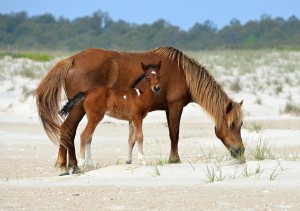
ASSATEAGUE — The joy of the birth of a new foal on Assateague this month was tempered somewhat with the discovery of the passing of a legend on the Chincoteague side.
The birth of the newest foal on Assateague sometime earlier this month brings the size of the herd on the Maryland side to 93. The new foal, temporarily known as N6BMT-FN, made her appearance last week in the back country south of South Beach and the Oversand-Vehicle Zone (OSV). She was born to the popular JoJo, or N6BMT-F.
In the mid-1970s, the National Park Service began naming new foals in the Assateague herd with an alpha-numeric code to help track the lineage and ancestry of the wild horses and identify to which sub-herd, or band, they belong and the areas on the island they are known to frequent. The new foal’s sire is likely Llama Boy as JoJo was a member of his band from last April to this May. However, JoJo and her new baby are now part of General Harker’s band, which can typically be found in the OSV area south of South Beach.
The new foal’s arrival comes on the cusp of the new summer season in and around Assateague, prompting the Assateague Island Alliance, the friends group of the National Seashore, to remind visitors to give the young family plenty of space. Those who might encounter the new foal, especially if the band comes closer to the developed zone, are urged to adhere to the strict guidelines while around the wild horses during the time of adjustment. Remember to maintain a distance of at least a bus length and do not approach, touch or feed the horses.
The addition of the new foal keeps the herd size well within the target range of 80 to 100. While three to five foals are birthed in a typical year, an in-kind number drop off due to old age, illness or other natural factors.
In the interest of managing the size of the herd, which left unchecked would overtake the barrier island and gobble up the resources the wild ponies need to survive, the National Park Service several years ago began a contraceptive program for the mares in the herd. The mares are injected with a non-invasive contraceptive to prevent multiple births in an effort to maintain and ultimately shrink the size of the herd to its manageable threshold. In the interest of maintaining the gene pool of the famous wild horses, believed to be descendants of domesticated horses placed on the island 300 years ago, each mare is allowed to birth one foal before being put on the contraceptive program.
The news of a new foal on the Maryland side came with the news of the passing of the famed “Surfer Dude” on the Chincoteague side. While the horses on the Maryland side are monitored by the AIA and the National Park officials, they are wild and come and go as they please. The horses on the Virginia side are owned and maintained by the Chincoteague Volunteer Fire Company.
Each July, the Chincoteague Volunteer Fire Company’s “Saltwater Cowboys” round up the herd on the Virginia side for a swim across the channel to Assateague where some are auctioned off to private owners. The rest swim back to their homes on the Virginia side of the barrier island.
Last week, the Chincoteague Volunteer Fire Company reported after weeks of searching, the remains of the beloved “Surfer Dude” were discovered in a remote clearing in the southern compound.
The famed “Surfer Dude” was 23 years old and a fixture in the Chincoteague herd for decades. The horse sired many foals over the years and was considered a patriarch of sorts for the Chincoteague herd. According to the Chincoteague VFC, “Surfer Dude’s” legacy on Assateague is as strong as the famed “Misty.”
